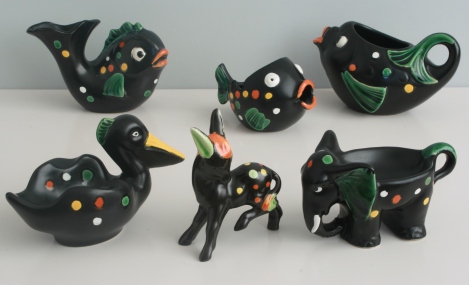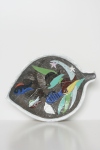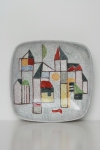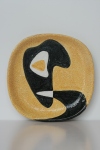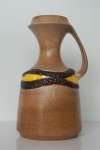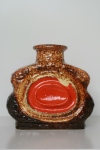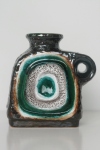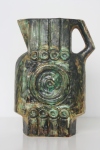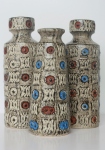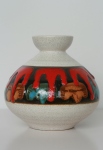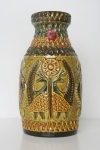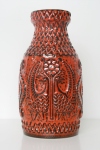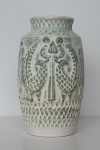May 24, 2020 New Wall mask galore ‘n stuff
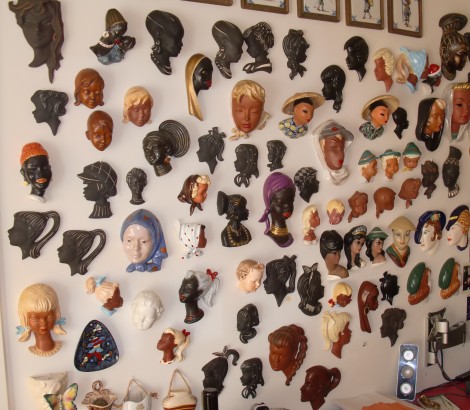
It is funny how some things run in the family, like collecting stupid amounts of stuff.
The pictures above and below were taken in my father’s house. Above you can see part of a wall that would accommodate about a hundred items, mostly German and Dutch wall masks, but also antique wall tiles and hand decorated plates. Below shows part of the other side of the room, where there would be at least 60 porcelain figurines. Where ever there would be some space left, you could find a plaque, wall tile or whatever and occasionally a small vase.
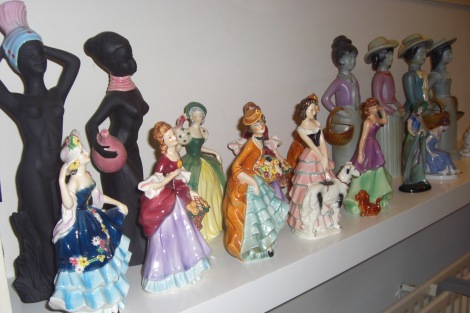
When my father passed away some years ago, this ceramic collection became all mine…
Back then I packed it all in boxes and the collection has been sitting there ever since, next to the boxes with a large part of my vase collection. I don’t have the space to put it all on display and although I like some of the figurines and wall masks, it is not really my thing. Besides, I like my walls a little less crowded.
However, for the sake of documentation I finally started unpacking some of it today. Got my Horst Makus handy for the necessary background (Horst Makus. (2000). 50er Jahre Wandmasken Schonheit und Exotik. Stuttgart: Arnoldsche). Did two boxes so far.
It does feel a bit like a feast of new discoveries, having them out of sight and out of mind for so long. Like unpacking a treasure. And I have to say, although maybe not my thing, I am rather starting to like these wall masks. They are quite beautiful. Will I warm up to the figurines as well? We will see.
Below are some I have unpacked today. Still many, many more to go. Argh, so much stuff, so little time…..
Tags: 1950s, coneye, cortendorf, gmundner, goebel, goldscheider, wall mask
- 1 comment
- Posted under wall masks
September 3, 2016 New in the picture gallery
Just to highlight some newer arrivals in the Picture Gallery!
Above left to right: Floor vase by Bay 265-40, Vase by Carstens Tönnieshof 7324-20, Vase by Bay 77-25, Vase by Scheurich 529-38.
Above top row left to right: Vase by Carstens Tönnieshof 191-30, Vase by Ilkra 2007-20, Vase by Scheurich 242-22, Vase by Carstens Tönnieshof 7905(?)-15
Above bottom row: Vase by Scheurich 549-21, Vase by Jopeko 909/15 and a Vase by Strehla 3092.
Above left to right: Vase by Jasba 198/25, Floor Vase by Eiwa(?),Vase by Bay 607-40, and a Vase by Strehla form number 1304 (thank you Micha for informing me on the form number!).
- Leave a comment
- Posted under Uncategorized
July 27, 2016 A pumpkin by Atelier Van Eyk
Since I do not find their pieces very often and having a soft spot for Atelier Van Eyk, I feel every piece by Anton and Dorothea Van Eyk deserves a post. So here it is, my latest, a globular vase looking somewhat like…… a pumpkin.
It is a peculiar piece, I think, compared to the 1950’s work that is probably more known (see below), so I am not very confident on putting a date on it. Of course, roughly speaking it would be between 1940-1960, unless it is a fake. The hand thrown body of the vase is a traditional globular shape and for a Van Eyk piece it seems quite large, being 16 cm/ 6.3″. It has a smooth white clay body with a thick orange glaze. The glaze decoration has the same elegant simplicity and shows similar care in spacing en execution as the other pieces I have from the 50’s. The thickness of the glaze and the colour combination I have not seen before, though.
I have this little black vase with a white twirl in the dents on all four sides, that seems more typical of their 1950’s work. It is around 7 cm/2.8″ in height and shown below left, next to a portrait of Anton and Dorothea Van Eyk.
For comparison and to broaden the scope beyond my own collection, I also gathered some images below of the more known work by Atelier Van Eyk from the 1950’s. I got part of these from the website of the current Atelier Van Eyk which operates, in line with the wishes of Anton van Eyk, as a place for art exhibitions, workshops, music recitals and theater. Link: Atelier Van Eyk . The images with the striped teapot and spotted vases….I can not remember the source of…. (archive of Wilhelmina Spolders?). Should you know the source, please let me know, so I can give due credit.
- Leave a comment
- Posted under 1950s, Uncategorized, Van Eyk
February 26, 2016 From a handle to a hole
Handles have always been used in creative ways in the design of pots. Especially in flower vases, where the practical need of the handle is limited, there has always been ample room to design the handles in expressive rather than practical ways, sometimes almost beyond recognition. But also in teapots and pitchers you can find stunningly creative designs, where there is even some practicality left. Below I gathered a few examples from ceramic history to illustrate this.
Similarly, with the creative boom in mid century German decorative pottery you can find all kinds of handles, from huge sweeping ones on floor vases to knob like handles on smaller vases and everything in between. Mostly, you will see the handles attached to the body as a separate part of the pot, which -in a way- is still rather conventional. But a paradigm shift had been set in earlier, that would also effect the handling of the handles. Below, first some examples from my own collection where body and handles are still clearly separate entities in the overall design. However, the relationship between body and handles was heading for new interpretations.
First some historic background (for those interested) in the tiniest nutshell
Already during the 19th and early 20th century, the separating lines between pottery, sculpture, architecture and painting had started to become blurred. Avant garde artists, designers and architects were striving to cross the boundaries between their respective fields, to create the Romantic ideal of the Gesamtkunstwerk, a perfect unity between all of the arts (fine, decorative and applied). Potters and ceramic designers who looked beyond their own field, were taking home new ideas to incorporate into their own work. From this point on and into the 20th century, next to traditional pottery, you can see pots appearing that are more painterly, more sculptural and more architectural then before. Potters were trying new things, other artists were discovering ceramics as a medium, architects incorporated work from ceramic artists and sculptors into their buildings, architects were doing ceramic designs, cross fertilizing the field. To illustrate some of this:
Painters and sculptors into ceramics:
Architects and designers into ceramics
Potters taking shapes and glazes to the next level:
So, there you go with a wellspring of creative and conceptual innovation taking place in the arts from the late 19th into the 20th century, emanating from a search for new ways within the art fields and from the cross-overs between the fields of pottery, sculpture, painting, design and architecture. Pottery traditions and techniques did not go overboard of course, but the approach of the painter, the sculptor and the architect/designer were added, opening up new ways of seeing things. Looking at post-war German art pottery, you can see pot makers mixing and matching (and sometimes mismatching) all of these influences into their designs. From my own collection:
The painterly: treating the body of the vase as a canvas for the expressive use of lines and colors:
The sculptural: with an original interplay of expressive shapes, textures, surface designs and glazes :
The (Modernist) architectural: integrating clear three dimensional shapes into an elegantly balanced whole:
Now: back to handles
But why did I start with handles? Some pots have them. Some pots do not. What is the big deal? Well, for all the interesting, new approaches to shapes, surface design, decors and glazes, I think the integration of the handles into the body of the vase is one of the most interesting conceptual innovations. Already in the vase design by architect Peter Behrens in the gallery above, you can see how the handles are being treated as part of the body of the vase, rather than just being attached to it. There are several examples in my collection where this is also the case.
However, the handles in the gallery above are still fairly recognizable as such. But what about the designs below? The handles have totally merged with the body. You might even say that in the Rosenthal designs by Beate Kuhn (left) the body of the so-called “Kummet” (meaning horse collar; thank you Carry for the right translation, see comments) vase has become one big handle.
Surely, it must have been the approach of the Modernist architect/designer influencing this handling of the handles in some of the most Modern pottery designs. “Things merely attached” (ornament) just won’t do in the Modernist mind. Everything has to be integrated into an aesthetic and rational whole, bringing down complexity to its essentials and leaving out all the fuss. What this meant for the handle, is beautifully demonstrated in the Rosenthal designs by Beate Kuhn (not part of my collection unfortunately).
So, what about the Dümler & Breiden vase on the right? Is that the logical conclusion of the handles merging with the body of the vase? I am guessing that might even be a bit of Post-Modernism avant la lettre. It is a bit tongue in cheek almost. Critiquing this Modernist trend with a sense of humour and putting the handle smack in the middle. From a handle to a hole.
- 2 comments
- Posted under Uncategorized
February 11, 2016 Update: A chess set made at Bay Keramik
I got a reaction from Ralf J. Schumann on my previous post about the chess set made at the Bay Keramik factory. Ralf contacted a former manager from Bay and this manager still remembered Nico Bongers, the intern who made the chess set. This is what he said about it:
Nico Bongers (the son of an important wholesaler of pottery, porcelain and glass in the Netherlands) stayed as an intern for about 6 weeks probably around the early 1970’s at Bay Keramik. He wanted to learn about the production of decorative ceramics and to improve his German speaking. Due to a personal hobby and as a souvenir he made the chess set by himself, probably created by him and certainly with the help of some modellers (“Modelleur” = modeller, someone who executed a design in ceramics. The design, mostly drawn just on paper before, could be created by the modeller himself or by a different designer). Who may have helped Mr. Bongers is not known anymore.The glaze may be a test glaze which was never used on an official Bay Keramik product range. It was not unusual to use a test glaze for single items.At no time there were thoughts at Bay Keramik to produce a chess set by themselves.
Well, this sheds some more light on the story behind the chess set. Thank you, Ralf!
*Ralf J. Schumann is a collector and researcher of West German ceramics from the 1950s. You can find his website through this link:
Ralf J. Schumann 1950s Keramiksammlung
- Leave a comment
- Posted under 1960s, 1970s, Bay
February 8, 2016 A Chess set made at Bay Keramik
The ceramic chess game in this post was made by a young Dutch man called Nico Bongers in the mid 60s, while he worked as an intern at Bay Keramik in Ransbach-Baumbach. I acquired it in 2014 from his widow Marianne, who had put it up for sale. The chess set had been sitting in a box on the attic for quite a number of years. There was no room to put it on display and Marianne Bongers thought it was a shame, so she decided to make somebody else happy with it. That happy someone turned out to be me.
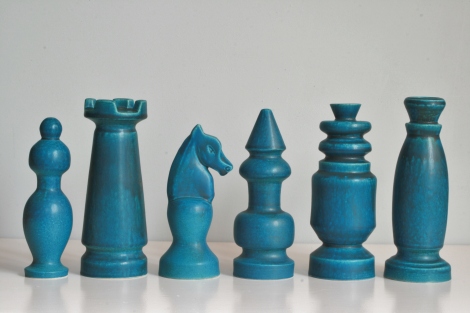 What caught my eye, besides it being a ceramic chess game, was the glaze. The red one looked a bit like the volcano glazes used by Ruscha and the turquoise like the ones used by Bay on the Rimini Blu-like pieces in the 1960s. It definitely had a mid-century German look to it. So when I went to pick it up, there turned out to be this interesting story of an internship at Bay Keramik behind the set.
What caught my eye, besides it being a ceramic chess game, was the glaze. The red one looked a bit like the volcano glazes used by Ruscha and the turquoise like the ones used by Bay on the Rimini Blu-like pieces in the 1960s. It definitely had a mid-century German look to it. So when I went to pick it up, there turned out to be this interesting story of an internship at Bay Keramik behind the set.
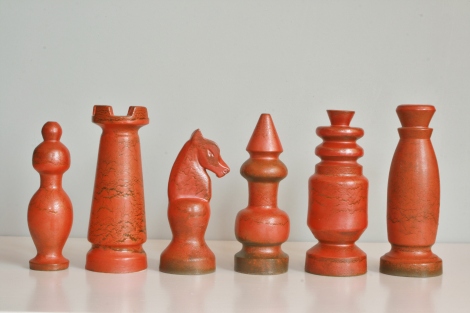 I have a complete set, plus 12 extra pieces. Nico designed and made six molds for casting the whole set. The individual shapes are shown above. The pieces are between 16 and 20 cm high, with simple nicely proportioned shapes. Twenty two pieces were cast for each colour. The excess of 6 pieces per colour all show some kind of imperfection. This really shows the process of making ceramics, with patches where the glaze turned out too thin, with shrinkage cracks in the piece, with runny glaze at the base, with chips….oops.
I have a complete set, plus 12 extra pieces. Nico designed and made six molds for casting the whole set. The individual shapes are shown above. The pieces are between 16 and 20 cm high, with simple nicely proportioned shapes. Twenty two pieces were cast for each colour. The excess of 6 pieces per colour all show some kind of imperfection. This really shows the process of making ceramics, with patches where the glaze turned out too thin, with shrinkage cracks in the piece, with runny glaze at the base, with chips….oops.
The matte blue glaze of the chess pieces was also used in the production of other Bay pieces. The red glaze on the other hand, I have never seen on any Bay piece. Was it an experiment? In the chess set, you can see the red volcano glaze is running over quite a shiny brown glaze. At the base of the red pieces, you can also see what can go wrong, when the volcano glaze starts to ripple 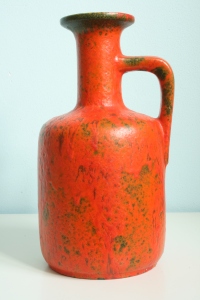 and it turns out to be a less then pretty finish. Maybe it was not such a succes and hence never taken into production? For comparison, to the left you can see a Ruscha piece with the volcano glaze running over a matte greenish glaze, where it may have behaved in a more controlled way. While in the Bay pieces the red volcano glaze tends to slide off sometimes. Or maybe there was enough volcano glaze to go around anyway? No need to flood the market with more. Who knows.
and it turns out to be a less then pretty finish. Maybe it was not such a succes and hence never taken into production? For comparison, to the left you can see a Ruscha piece with the volcano glaze running over a matte greenish glaze, where it may have behaved in a more controlled way. While in the Bay pieces the red volcano glaze tends to slide off sometimes. Or maybe there was enough volcano glaze to go around anyway? No need to flood the market with more. Who knows.
The chess set was also not taken into production. Probably, it was a bit too large for most households to own. It is not a chess set you can throw into the cupboard when you are done playing, like you would with the little wooden or plastic pieces. Where to put it? Aha, in a box in the attic! It would likely not have been a commercial succes.
So, this set is a one-off, I guess. Nico Bongers did not continue in a career as a potter or an industrial designer of such. He went on to own his own ceramics shop in the east of the Netherlands, which I am sure he did a fine job at. But judging from his work as an intern, I think he would have made an excellent designer too. I am glad to share in this post the evidence of his talent.
- Leave a comment
- Posted under 1960s, Bay, Bodo Mans, Uncategorized, West Germany
February 5, 2016 New in the Picture Gallery
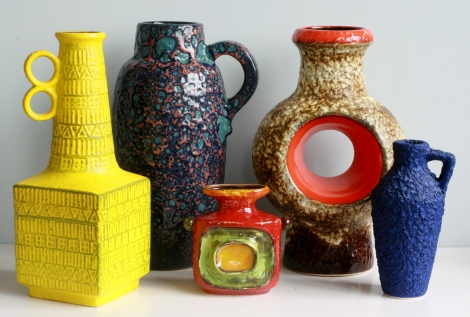
Top left to right: Large vase by Dümler & Breiden form number 493-35, small vase by Oberhessische keramik form number WB 145/15, large vase by Scheurich 420-38, small vase by Schlossberg decor Cuba.
Bottom left to right: Two wall plates from the Teenager series by Ü-Keramik design: Ursula Schönhaber, 1960. Marked: 568-22, large vase in green by Bay design: Bodo Mans form number 257-35.
- Leave a comment
- Posted under Uncategorized
September 19, 2015 Schmider Full House?
With the acquisition of the elephant dish (below right), my Schmider figurines collection must now be pretty much complete. That is to say, I am not aware of any other type of figurine I could add in this particular series. If anyone else has seen a variation, of course I am dying to hear about it!
Tags: 1950s, Anneliese Beckh, Schmider
- 7 comments
- Posted under 1950s, Anneliese Beckh
September 13, 2015 New in the Picture Gallery
Left to right: plate by Anna-Lisa Thomson for Upsala Ekeby Havsflora series 1951-60 (Sweden), plate signed Venezia Italy, plate signed 364 Italy, vase by Steuler marked 315/35.
Left to right: vase by Oberhessische Keramik marked U4/24, vase by Oberhessische Keramik marked U3/20, vase by Schlossberg marked 509/25, three vases by Spara by Turkish designer Halidun Kutlu 1970s.
Left to right: vase by Dumler & Breiden (?), three vases by Bay with peacock decor
- 1 comment
- Posted under Uncategorized
August 8, 2015 Exhibition 20th Century in Princessehof National Museum of Ceramics in Leeuwarden, Netherlands
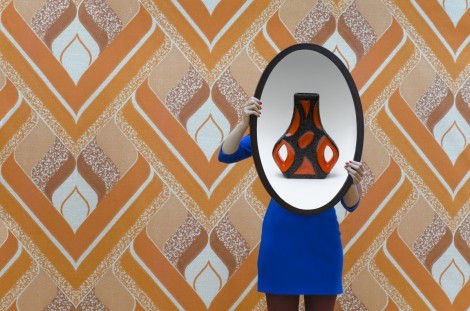
Photography and concept Heleen Haijtema. Dorothea Roth, vase, 1970-1975, Roth Eberhahn West Germany. Collection Petra Mesken
In September 2015 a new exhibition will open in the renowned Princessehof National Museum of Ceramics in Leeuwarden, the Netherlands. I am very exited about this, because 11 objects (vases, jugs and wall plates) from my collection will be in it! The exhibition will focus on ceramics mirroring the trends and social changes during the 20th century. Think of women’s liberation, the rise of the teenager, the rise of exotic travel destinations, space travel, individualism, consumerism, massproduction etc. About 400 ceramic objects will be showcased alongside other objects like furniture, paintings, film, photographs and an original 1960s caravan, offering a picture of the turbulent 20th century and its Zeitgeist.
Obviously, I can’t wait for it to open. It should be a very interesting exhibition. And on the exhibition poster, none other than my beautiful Roth Ebernhahn guitar vase.
If you are in the neighbourhood, be sure to go see it!
The 20th century – mirroring time in ceramics can be seen in the Princessehof National Museum of Ceramics, Leeuwarden, The Netherlands from September 5 -2015 until July 3 -2016.
More info via this link: The 20th century – mirroring time in ceramics
- Leave a comment
- Posted under Uncategorized




































































































